Difference between revisions of "Ricohflex B"
Rebollo fr (talk | contribs) (more) |
Hanskerensky (talk | contribs) m (→Variations: Replaced location of rebollo_fr image due to expected deletion of images on Flickr March 2019, /photos/rebollo_fr/3671632322) |
||
| (35 intermediate revisions by 5 users not shown) | |||
| Line 1: | Line 1: | ||
| − | {{Japanese | + | {{Japanese 6×6 TLR (A–L) |
| − | + | |image=[http://www.flickr.com/photos/camerawiki/47255588842/in/pool-camerawiki/ http://farm8.staticflickr.com/7850/47255588842_a4bfe55903_m_d.jpg]<br>''Picture courtesy of Harris Aaronson. {{with permission}}'' | |
| − | {{ | + | }} |
| + | The '''Ricohflex B''' (理光フレックスB型) is a Japanese 6×6 [[TLR]] made and sold by [[Ricoh|Riken Kōgaku Kōgyō]] in 1941 and 1942.<REF> Dates: advertisements listed in {{Kokusan}}, p.343. </REF> The body of the Ricohflex B was reused after the war for the '''Luminaflex''' (ルミナフレックス), perhaps assembled by a different company. | ||
| − | The | + | == Description == |
| + | The Ricohflex B is a 6×6 TLR made of pressed steel.<REF> Pressed steel: see [http://ext.ricoh.co.jp/camera_lib/library/1936b.html this page of the Ricoh website]. </REF> It is a close copy of the export versions of the [[Richter]] [[Reflecta]] with three red windows, like the [[Trumpfreflex]] or the [[Wirgin Reflex]].<REF> Tomuro, pp.72–77 of {{KKS}} no.14, demonstrates that the Ricohflex B is a copy of the [[Sears]] Trumpfreflex because it has three red windows, the exact same depth-of-field plate and distance scale. However other name variants of the Reflecta have the same features, like the Wirgin Reflex sold by [[Wirgin]]. See {{MK}}, p.1014. </REF> The focusing is done by a lever at the bottom of the taking lens, driving a helicoid supporting the lens and shutter assembly. The viewing lens is attached to the helical too, and moves together with the taking lens. The closest focusing distance is 3.5 feet (the distance scale is exactly the same as on the export versions of the [[Reflecta]]). | ||
| + | |||
| + | The exposure chamber and film spool holders are grouped in a removable frame. The film advance knob is on the photographer's right. The back is hinged to the top and contains three [[red window]]s on the left, protected by a vertically sliding cover. Indications are embossed in the back leather next to the red windows: ''1357,'' ''2468'' and ''1357,'' meant to use the 1 to 12 series of numbers for the 6×9 format. This advance system was necessary for 6×6 cameras in the early 1930s, when the rollfilm paper backing was not yet marked for the 6×6 frame size, but it was antiquated at the time the model was sold. | ||
| + | |||
| + | {| class="plainlinks" align="center" style="text-align: center;" | ||
| + | || [http://www.flickr.com/photos/camerawiki/47258444802/in/pool-camerawiki/ http://farm8.staticflickr.com/7872/47258444802_2031ec1a1a_m_d.jpg] [http://www.flickr.com/photos/camerawiki/46395921565/in/pool-camerawiki/ http://farm8.staticflickr.com/7862/46395921565_68c6ef4420_m_d.jpg] | ||
| + | |- | ||
| + | || [http://www.flickr.com/photos/camerawiki/46587557384/in/pool-camerawiki/ http://farm8.staticflickr.com/7830/46587557384_f7e38003eb_m_d.jpg] [http://www.flickr.com/photos/camerawiki/40345959643/in/pool-camerawiki/ http://farm8.staticflickr.com/7886/40345959643_49979d3e21_m_d.jpg] | ||
| + | |- | ||
| + | || ''Ricohflex B, everset shutter (25–150, B, T), Triver Anastigmat 75mm f/4.5 lenses.<br>Pictures courtesy of Harris Aaronson. {{with permission}}'' | ||
| + | |} | ||
| + | There is a [[depth-of-field]] plate on the back of the viewing hood, written in English; it is again exactly the same as on the export versions of the [[Reflecta]], even including a column for f/3.5 aperture whereas the camera only has an f/4.5 lens. Unlike most other TLR cameras, the Ricohflex B has no magnifying lens in the viewing hood. Strap attachments are mounted on both sides of the body. The nameplate is inscribed ''Ricohflex'' and ''MOD.B''. | ||
| − | == | + | == Advertisements and other documents == |
| − | + | A user guide for the postwar [[Ricohflex (geared lens)|geared lens Ricohflex]] published in 1951 reportedly says that the first Ricohflex, called Ricohflex A, was developed and tested in 1936.<REF> ''Rikōfurekkusu no tsukaikata'' (リコーフレックスの使いかた), written by Yagi Osamu (八木治) and published in July 1951 by Sōgeisha (双芸社). Quoted in Hayashi, p.136 of {{KKS}} no.4. </REF> It is described as a [[pseudo TLR]] with a fixed-focus viewing lens and a front-cell focusing f/4.5 taking lens. The camera is clearly not the same as the [[Ricohflex (original)|original Ricohflex]], called "Ricohflex A" in some recent sources. It might be an experimental predecessor of the Ricohflex B or an altogether different camera, if not a plain mistake. | |
| − | + | A Ricohflex B already appears in the official price list compiled in October 1940 and published in January 1941.<REF> {{Kakaku0141_short}}, type 7, section 1. </REF> The document strangely quotes the same price of ¥252 for all listed TLR models, including the Ricohflex B despite its lesser features. This might be a mistake, or might indicate that the camera was only planned and officially registered as a TLR with no further detail, but not yet ready to sell. | |
| − | + | The Ricohflex B is listed for {{yen|140|1941}} in advertisements dated October and December 1941, and for {{yen|166|1942}} in an advertisement dated March 1942.<REF> Advertisement in {{SB}} October 1941, reproduced in Tanaka, p.10 of {{KKS}} no.14; advertisement in {{SB}} December 1941, reproduced in Nakamura, p.32 of {{CCN}} no.171; [http://syasinsyuu.cool.ne.jp/camera/syasinki19.jpg advertisement] in ''[[Hōdō Shashin]]'' March 1942, reproduced in {{Kokusan}}, p.102. </REF> In the documents, the lens is described as an RKK Koa Anastigmat 75/4.5, and the shutter is said to have a setting lever. The pictured camera is the same in all three advertisements. It has a rectangular nameplate, with ''<small>MOD.B</small>'' in small capital letters, and has no marking on the shutter plate. | |
| − | + | The '''Luminaflex''' is featured in the June 1949 issue of {{KG}}.<REF> {{Kokusan}}, p.373. </REF> It was apparently made from Ricohflex B spare bodies and reportedly sold quickly at a comparatively cheap price.<REF> {{Kokusan}}, p.373. </REF> | |
== Variations == | == Variations == | ||
| − | + | All the actual examples observed so far have an incurved nameplate, different from that pictured in the original advertisements. The marking ''MOD.B'' is written in larger letters. | |
| − | + | Various lens and shutter versions are known. Some shutters are [[everset]] and have a round ''AKK'' logo, indicating that they were made by [[Asahi Bussan|Asahi Kōgaku Kōgyō]], a dependent company of [[Ricoh|Riken]]. One of these has a ''HEIL'' nameplate attached to the top, and gives 5–200, B, T speeds. It sometimes comes with a pair of Ukas Anastigmat 75mm f/4.5 lenses, of the type found on various other Riken cameras.<REF> Example pictured in Tanaka, p.20 of {{KKS}} no.14, and in Tomuro, pp.72–3 of the same magazine. </REF> A similar shutter, with missing front plate, has also been observed with a pair of [[Nishida lenses|Wester Anastigmat]] 75mm f/4.5 lenses made by [[Nishida]].<REF> Example observed in an online auction. </REF> The example pictured in [http://ext.ricoh.co.jp/camera_lib/library/1936b.html this page] of the Ricoh official website might have a different everset shutter. | |
| − | + | {| class="plainlinks" align="center" style="text-align: center;" | |
| + | || [http://www.flickr.com/photos/camerawiki/47255588842/in/pool-camerawiki/ http://farm8.staticflickr.com/7850/47255588842_a4bfe55903_m_d.jpg] [http://www.flickr.com/photos/camerawiki/47258523072/in/pool-camerawiki/ http://farm8.staticflickr.com/7905/47258523072_9019c43eb9_m_d.jpg] | ||
| + | |- | ||
| + | || ''Ricohflex B, everset shutter (25–150, B, T), Triver Anastigmat 75mm f/4.5 lenses.<br>Pictures courtesy of Harris Aaronson. {{with permission}}'' | ||
| + | |} | ||
| − | It is | + | The example pictured above has yet another [[everset]] shutter by [[Asahi Bussan|Asahi Kōgaku Kōgyō]], with lesser specifications. It gives 25–150, B, T speeds, and is marked ''VEST OLYMPIC'' at the top; it is certainly the Fiskus shutter normally found on the [[Vest Alex and Vest Olympic|Vest Olympic]]. The camera has a pair of Triver Anastigmat 75mm f/4.5 lenses. The camera comes in a brown leather case embossed ''Luminous'' at the front — the brand name Luminous was used for filters by Riken Kōki, another company of the Riken group. |
| − | + | The most common version of the Ricohflex B has a no-name shutter, giving T, B, 5–200 speeds, with a single lever on the side used for cocking and release. It normally comes with a pair of R.K.K. Koa Anastigmat lenses, engraved ''R.K.K. KōA ANASTIGMAT 1:4.5 f=7.5cm'', with four-digit serial numbers in the 3xxx or 4xxx range.<REF> Example pictured in {{SUG}}, item 2020, example pictured in ''Watakushi no ni-gan-refu kamera-ten'', p.21, and in Lewis, p.57, example pictured in Hayashi, p.136 of {{KKS}} no.4, and examples observed in online auctions. </REF> Some recent sources say that these cameras version came after those with everset shutter, but nothing is confirmed for sure.<REF> Tanaka, p.20 of {{KKS}} no.14, and Tomuro, p.72 of the same magazine. </REF> | |
| − | The Ricohflex B | ||
| − | + | Finally, a wrecked camera with missing nameplate has been observed in an online auction with a number of unusual features. It might be one of the postwar Luminaflex, but nothing is confirmed. The body is identical to that of the Ricohflex B but for a few details. The front standard has a chrome trim all around. The back has a single red window in the middle, but the sliding lever controlling the red window cover is the same as on the regular cameras. The viewing lens is a Triver Anastigmat,<REF> Tribar spelling inferred from the ''katakana'' トリバー, and from the Triver Anastigmat name found on the camera pictured in this article. </REF> but its maximal aperture might be higher than 4.5 (maybe f/3.5 or f/3.2). The original shutter and taking lens apparently went missing, and the camera was offered in the auction with a [[Nishida lenses|Wester Anastigmat]] 7.5cm f/3.5 taking lens and an unmarked shutter (T, B, 1–200, self-timer). The lens and shutter assembly was not mounted on the camera, and it was reported not to fit very well on the body. The auction included a ''Luminous'' leather case, similar to that pictured above. There might be some relationship between the "Luminous" and "Luminaflex" brand names. | |
== Notes == | == Notes == | ||
| Line 32: | Line 48: | ||
== Bibliography == | == Bibliography == | ||
| − | * {{Showa10}} | + | * {{Showa10}} Items 311 and 1029. |
| − | * {{Lewis}} P. | + | * Hayashi Teruaki (林輝昭). "Kamera taishūka no kōrōsha Rikōfurekkusu" (カメラ大衆化の功労者リコーフレックス, The Ricohflex, a deserving effort to popularize cameras). {{KKS004}} Pp.136–9. |
| − | * {{McKeown12}} P. | + | * {{Kakaku0141}} Type 7, section 1. |
| + | * {{Lewis}} P.57. | ||
| + | * {{McKeown12}} P.832. (See also pp.823–4, 883 and 1014 for the [[Reflecta]] and its name variants.) | ||
| + | * Nakamura Kin (中村欽). "Hanseiki-mae no kugatsu ni wa..." (半世紀前の九月には..., Half a century ago...). In {{CCN}} no.171 (September 1991). Nishinomiya: Camera Collectors News-sha. P.32. | ||
* {{Zukan}} Item 2020. | * {{Zukan}} Item 2020. | ||
| − | * Tanaka Masao (田中政雄). "Rikō kamera no nagare" (リコーカメラの流れ, Evolution of the Ricoh cameras). {{KKS014}} Pp. | + | * Tanaka Masao (田中政雄). "Rikō kamera no nagare" (リコーカメラの流れ, Evolution of the Ricoh cameras). {{KKS014}} Pp.8–11. |
| − | * Tanaka Masao (田中政雄). "Senzen no kamera 3: Nigan-refu kamera" (戦前のカメラ3・二眼レフカメラ, Prewar cameras 3: TLR cameras). {{KKS014}} Pp. | + | * Tanaka Masao (田中政雄). "Senzen no kamera 3: Nigan-refu kamera" (戦前のカメラ3・二眼レフカメラ, Prewar cameras 3: TLR cameras). {{KKS014}} Pp.19–20. |
| − | * Tomuro Seiwa (戸室靖和). "Rikōfurekkusu B-gata no rūtsu | + | * Tomuro Seiwa (戸室靖和). "Rikōfurekkusu B-gata no rūtsu o saguru" (リコーフレックスB型のルーツを探る, Looking for the roots of the Ricohflex B). {{KKS014}} Pp.72–8. |
| − | * ''Watakushi no ni-gan-refu kamera-ten'' (私の二眼レフカメラ展, Exhibition of twin lens reflex cameras). Tokyo: JCII Camera Museum, 1992. (Exhibition catalogue, no ISBN number.) P. | + | * ''Watakushi no ni-gan-refu kamera-ten'' (私の二眼レフカメラ展, Exhibition of twin lens reflex cameras). Tokyo: JCII Camera Museum, 1992. (Exhibition catalogue, no ISBN number.) P.21. |
== Links == | == Links == | ||
In Japanese: | In Japanese: | ||
* Pages from [http://www.ricoh.co.jp/camera/ the Ricoh corporate site]: | * Pages from [http://www.ricoh.co.jp/camera/ the Ricoh corporate site]: | ||
| − | ** [http://www.ricoh.co.jp/ | + | ** [http://www.ricoh-imaging.co.jp/japan/products/ricoh-filmcamera/cameralist/flexB.html Ricohflex B] in the [http://www.ricoh-imaging.co.jp/japan/products/ricoh-filmcamera/cameralist/ Ricoh camera list] (copied in [http://navi.kitamura.jp/camera/0000002222.html this page of the Kitamura Camera Museum]) |
** [http://ext.ricoh.co.jp/camera_lib/library/1936b.html article about the Ricohflex B] | ** [http://ext.ricoh.co.jp/camera_lib/library/1936b.html article about the Ricohflex B] | ||
| − | * [http:// | + | * [http://www.remus.dti.ne.jp/~inasan99/camera/b_camera/automat42_l.jpg Advertisement for the Heil C] dated 1942, also listing the Ricohflex B, reproduced in [http://www.remus.dti.ne.jp/~inasan99/camera/nostalgic_camera.html Nostalgic Camera], a page of old Japanese advertisements by Toshio Inamura |
| − | + | In french: | |
| + | * [http://www.flickr.com/photos/27548522@N02/sets/72157624879506862/with/4958404800/ More Ricohflex B pictures] | ||
{{riken prewar}} | {{riken prewar}} | ||
Latest revision as of 18:28, 7 March 2019
The Ricohflex B (理光フレックスB型) is a Japanese 6×6 TLR made and sold by Riken Kōgaku Kōgyō in 1941 and 1942.[1] The body of the Ricohflex B was reused after the war for the Luminaflex (ルミナフレックス), perhaps assembled by a different company.
Contents
Description
The Ricohflex B is a 6×6 TLR made of pressed steel.[2] It is a close copy of the export versions of the Richter Reflecta with three red windows, like the Trumpfreflex or the Wirgin Reflex.[3] The focusing is done by a lever at the bottom of the taking lens, driving a helicoid supporting the lens and shutter assembly. The viewing lens is attached to the helical too, and moves together with the taking lens. The closest focusing distance is 3.5 feet (the distance scale is exactly the same as on the export versions of the Reflecta).
The exposure chamber and film spool holders are grouped in a removable frame. The film advance knob is on the photographer's right. The back is hinged to the top and contains three red windows on the left, protected by a vertically sliding cover. Indications are embossed in the back leather next to the red windows: 1357, 2468 and 1357, meant to use the 1 to 12 series of numbers for the 6×9 format. This advance system was necessary for 6×6 cameras in the early 1930s, when the rollfilm paper backing was not yet marked for the 6×6 frame size, but it was antiquated at the time the model was sold.
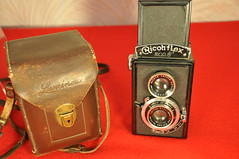 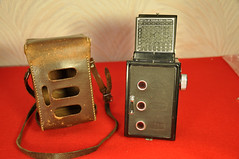
|
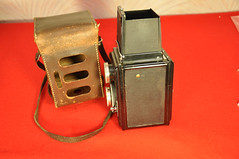 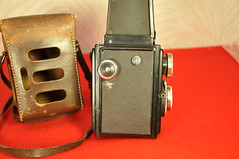
|
| Ricohflex B, everset shutter (25–150, B, T), Triver Anastigmat 75mm f/4.5 lenses. Pictures courtesy of Harris Aaronson. (Image rights) |
There is a depth-of-field plate on the back of the viewing hood, written in English; it is again exactly the same as on the export versions of the Reflecta, even including a column for f/3.5 aperture whereas the camera only has an f/4.5 lens. Unlike most other TLR cameras, the Ricohflex B has no magnifying lens in the viewing hood. Strap attachments are mounted on both sides of the body. The nameplate is inscribed Ricohflex and MOD.B.
Advertisements and other documents
A user guide for the postwar geared lens Ricohflex published in 1951 reportedly says that the first Ricohflex, called Ricohflex A, was developed and tested in 1936.[4] It is described as a pseudo TLR with a fixed-focus viewing lens and a front-cell focusing f/4.5 taking lens. The camera is clearly not the same as the original Ricohflex, called "Ricohflex A" in some recent sources. It might be an experimental predecessor of the Ricohflex B or an altogether different camera, if not a plain mistake.
A Ricohflex B already appears in the official price list compiled in October 1940 and published in January 1941.[5] The document strangely quotes the same price of ¥252 for all listed TLR models, including the Ricohflex B despite its lesser features. This might be a mistake, or might indicate that the camera was only planned and officially registered as a TLR with no further detail, but not yet ready to sell.
The Ricohflex B is listed for ¥140 in advertisements dated October and December 1941, and for ¥166 in an advertisement dated March 1942.[6] In the documents, the lens is described as an RKK Koa Anastigmat 75/4.5, and the shutter is said to have a setting lever. The pictured camera is the same in all three advertisements. It has a rectangular nameplate, with MOD.B in small capital letters, and has no marking on the shutter plate.
The Luminaflex is featured in the June 1949 issue of Kohga Gekkan.[7] It was apparently made from Ricohflex B spare bodies and reportedly sold quickly at a comparatively cheap price.[8]
Variations
All the actual examples observed so far have an incurved nameplate, different from that pictured in the original advertisements. The marking MOD.B is written in larger letters.
Various lens and shutter versions are known. Some shutters are everset and have a round AKK logo, indicating that they were made by Asahi Kōgaku Kōgyō, a dependent company of Riken. One of these has a HEIL nameplate attached to the top, and gives 5–200, B, T speeds. It sometimes comes with a pair of Ukas Anastigmat 75mm f/4.5 lenses, of the type found on various other Riken cameras.[9] A similar shutter, with missing front plate, has also been observed with a pair of Wester Anastigmat 75mm f/4.5 lenses made by Nishida.[10] The example pictured in this page of the Ricoh official website might have a different everset shutter.
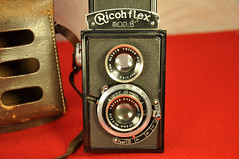 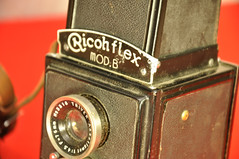
|
| Ricohflex B, everset shutter (25–150, B, T), Triver Anastigmat 75mm f/4.5 lenses. Pictures courtesy of Harris Aaronson. (Image rights) |
The example pictured above has yet another everset shutter by Asahi Kōgaku Kōgyō, with lesser specifications. It gives 25–150, B, T speeds, and is marked VEST OLYMPIC at the top; it is certainly the Fiskus shutter normally found on the Vest Olympic. The camera has a pair of Triver Anastigmat 75mm f/4.5 lenses. The camera comes in a brown leather case embossed Luminous at the front — the brand name Luminous was used for filters by Riken Kōki, another company of the Riken group.
The most common version of the Ricohflex B has a no-name shutter, giving T, B, 5–200 speeds, with a single lever on the side used for cocking and release. It normally comes with a pair of R.K.K. Koa Anastigmat lenses, engraved R.K.K. KōA ANASTIGMAT 1:4.5 f=7.5cm, with four-digit serial numbers in the 3xxx or 4xxx range.[11] Some recent sources say that these cameras version came after those with everset shutter, but nothing is confirmed for sure.[12]
Finally, a wrecked camera with missing nameplate has been observed in an online auction with a number of unusual features. It might be one of the postwar Luminaflex, but nothing is confirmed. The body is identical to that of the Ricohflex B but for a few details. The front standard has a chrome trim all around. The back has a single red window in the middle, but the sliding lever controlling the red window cover is the same as on the regular cameras. The viewing lens is a Triver Anastigmat,[13] but its maximal aperture might be higher than 4.5 (maybe f/3.5 or f/3.2). The original shutter and taking lens apparently went missing, and the camera was offered in the auction with a Wester Anastigmat 7.5cm f/3.5 taking lens and an unmarked shutter (T, B, 1–200, self-timer). The lens and shutter assembly was not mounted on the camera, and it was reported not to fit very well on the body. The auction included a Luminous leather case, similar to that pictured above. There might be some relationship between the "Luminous" and "Luminaflex" brand names.
Notes
- ↑ Dates: advertisements listed in Kokusan kamera no rekishi, p.343.
- ↑ Pressed steel: see this page of the Ricoh website.
- ↑ Tomuro, pp.72–77 of Kurashikku Kamera Senka no.14, demonstrates that the Ricohflex B is a copy of the Sears Trumpfreflex because it has three red windows, the exact same depth-of-field plate and distance scale. However other name variants of the Reflecta have the same features, like the Wirgin Reflex sold by Wirgin. See McKeown, p.1014.
- ↑ Rikōfurekkusu no tsukaikata (リコーフレックスの使いかた), written by Yagi Osamu (八木治) and published in July 1951 by Sōgeisha (双芸社). Quoted in Hayashi, p.136 of Kurashikku Kamera Senka no.4.
- ↑ "Kokusan shashinki no kōtei kakaku", type 7, section 1.
- ↑ Advertisement in Shashin Bunka October 1941, reproduced in Tanaka, p.10 of Kurashikku Kamera Senka no.14; advertisement in Shashin Bunka December 1941, reproduced in Nakamura, p.32 of Camera Collectors' News no.171; advertisement in Hōdō Shashin March 1942, reproduced in Kokusan kamera no rekishi, p.102.
- ↑ Kokusan kamera no rekishi, p.373.
- ↑ Kokusan kamera no rekishi, p.373.
- ↑ Example pictured in Tanaka, p.20 of Kurashikku Kamera Senka no.14, and in Tomuro, pp.72–3 of the same magazine.
- ↑ Example observed in an online auction.
- ↑ Example pictured in Sugiyama, item 2020, example pictured in Watakushi no ni-gan-refu kamera-ten, p.21, and in Lewis, p.57, example pictured in Hayashi, p.136 of Kurashikku Kamera Senka no.4, and examples observed in online auctions.
- ↑ Tanaka, p.20 of Kurashikku Kamera Senka no.14, and Tomuro, p.72 of the same magazine.
- ↑ Tribar spelling inferred from the katakana トリバー, and from the Triver Anastigmat name found on the camera pictured in this article.
Bibliography
- Asahi Camera (アサヒカメラ) editorial staff. Shōwa 10–40nen kōkoku ni miru kokusan kamera no rekishi (昭和10–40年広告にみる国産カメラの歴史, Japanese camera history as seen in advertisements, 1935–1965). Tokyo: Asahi Shinbunsha, 1994. ISBN 4-02-330312-7. Items 311 and 1029.
- Hayashi Teruaki (林輝昭). "Kamera taishūka no kōrōsha Rikōfurekkusu" (カメラ大衆化の功労者リコーフレックス, The Ricohflex, a deserving effort to popularize cameras). Kamera Rebyū: Kurashikku Kamera Senka (カメラレビュー クラシックカメラ専科) / Camera Review: All about Historical Cameras no.4, March 1984. No ISBN number. Meiki no keifu (名機の系譜, special issue on famous camera families). Pp.136–9.
- "Kokusan shashinki no kōtei kakaku" (国産写真機の公定価格, Set prices of the Japanese cameras), listing Japanese camera production as of October 25, 1940 and setting the retail prices from December 10, 1940. Published in Asahi Camera January 1941 and reproduced in Shōwa 10—40nen kōkoku ni miru kokusan kamera no rekishi (昭和10〜40年広告にみる国産カメラの歴史, Japanese camera history as seen in advertisements, 1935—1965). Tokyo: Asahi Shinbunsha, 1994. ISBN 4-02-330312-7. Pp.108—9. Type 7, section 1.
- Lewis, Gordon, ed. The History of the Japanese Camera. Rochester, N.Y.: George Eastman House, International Museum of Photography & Film, 1991. ISBN 0-935398-17-1 (paper), 0-935398-16-3 (hard). P.57.
- McKeown, James M. and Joan C. McKeown's Price Guide to Antique and Classic Cameras, 12th Edition, 2005-2006. USA, Centennial Photo Service, 2004. ISBN 0-931838-40-1 (hardcover). ISBN 0-931838-41-X (softcover). P.832. (See also pp.823–4, 883 and 1014 for the Reflecta and its name variants.)
- Nakamura Kin (中村欽). "Hanseiki-mae no kugatsu ni wa..." (半世紀前の九月には..., Half a century ago...). In Camera Collectors' News no.171 (September 1991). Nishinomiya: Camera Collectors News-sha. P.32.
- Sugiyama, Kōichi (杉山浩一); Naoi, Hiroaki (直井浩明); Bullock, John R. The Collector's Guide to Japanese Cameras. 国産カメラ図鑑 (Kokusan kamera zukan). Tokyo: Asahi Sonorama, 1985. ISBN 4-257-03187-5. Item 2020.
- Tanaka Masao (田中政雄). "Rikō kamera no nagare" (リコーカメラの流れ, Evolution of the Ricoh cameras). Kamera Rebyū: Kurashikku Kamera Senka (カメラレビュー クラシックカメラ専科) / Camera Review: All about Historical Cameras no.14, October 1989. No ISBN number. Rikō kamera no subete (リコーカメラのすべて, special issue on Ricoh). Pp.8–11.
- Tanaka Masao (田中政雄). "Senzen no kamera 3: Nigan-refu kamera" (戦前のカメラ3・二眼レフカメラ, Prewar cameras 3: TLR cameras). Kamera Rebyū: Kurashikku Kamera Senka (カメラレビュー クラシックカメラ専科) / Camera Review: All about Historical Cameras no.14, October 1989. No ISBN number. Rikō kamera no subete (リコーカメラのすべて, special issue on Ricoh). Pp.19–20.
- Tomuro Seiwa (戸室靖和). "Rikōfurekkusu B-gata no rūtsu o saguru" (リコーフレックスB型のルーツを探る, Looking for the roots of the Ricohflex B). Kamera Rebyū: Kurashikku Kamera Senka (カメラレビュー クラシックカメラ専科) / Camera Review: All about Historical Cameras no.14, October 1989. No ISBN number. Rikō kamera no subete (リコーカメラのすべて, special issue on Ricoh). Pp.72–8.
- Watakushi no ni-gan-refu kamera-ten (私の二眼レフカメラ展, Exhibition of twin lens reflex cameras). Tokyo: JCII Camera Museum, 1992. (Exhibition catalogue, no ISBN number.) P.21.
Links
In Japanese:
- Pages from the Ricoh corporate site:
- Advertisement for the Heil C dated 1942, also listing the Ricohflex B, reproduced in Nostalgic Camera, a page of old Japanese advertisements by Toshio Inamura
In french:
| Asahi Bussan and Riken prewar and wartime cameras () | ||
|---|---|---|
| rigid or collapsible | ||
| Vest Adler | Gokoku | Semi Kinsi | Letix | Olympic | New Olympic | Regal Olympic | Semi Olympic | Super Olympic | Vest Olympic | Riken No.1 | Ricohl | Roico | Seica | Zessan | ||
| folders | pseudo TLR | TLR |
| Semi Adler | Adler III | Adler A | Adler B | Adler C | Adler Four | Adler Six | Gaica | Heil | Kinsi | Chukon Ref | Ricohflex | Ricohflex B |